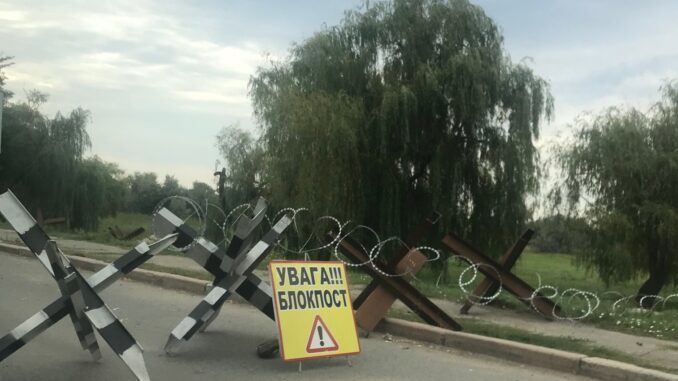
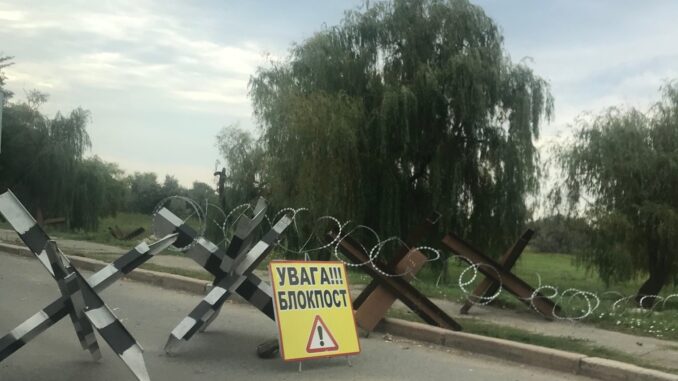
Note: Shawn Krest is embedded with a humanitarian aid group delivering food in the Ukraine. This is the fourth installment of his report on the experience. You can read the first three at
Keep on truckin’: First impression of Ukraine – The North State Journal (nsjonline.com)
Keep off the grass: Entering the war zone – The North State Journal (nsjonline.com)
In the early days of the war, the drivers from A Jesus Mission brough food into the Ukraine and delivered it. They would purchase it in Romania and store it in a warehouse in Cluj, loading up the vans before rushing into the country to make the drop offs.
Things have evolved over time, and the grassroots effort has partnered with some other charities. Now, the vans make the trip in empty, except for cans of gas and the drivers’ belongings. The food arrives in semi trucks, in boxes marked with logos of Kids Against Hunger, Hope Box Meals from the Heartland and Feed My Starving Children.
The church organizes the food supply, storing it in various locations and determining who needs it most. A chunk of it goes to people around the city—we had to deliver the “daily rations” to other churches scattered around the metro area, where people could come to collect their individual bags later in the day.
Most of the food, however, is earmarked for villages outside the city, closer to the front lines. That’s where we come in.
“We go to the places no one else will,” team leader Shannon explains.
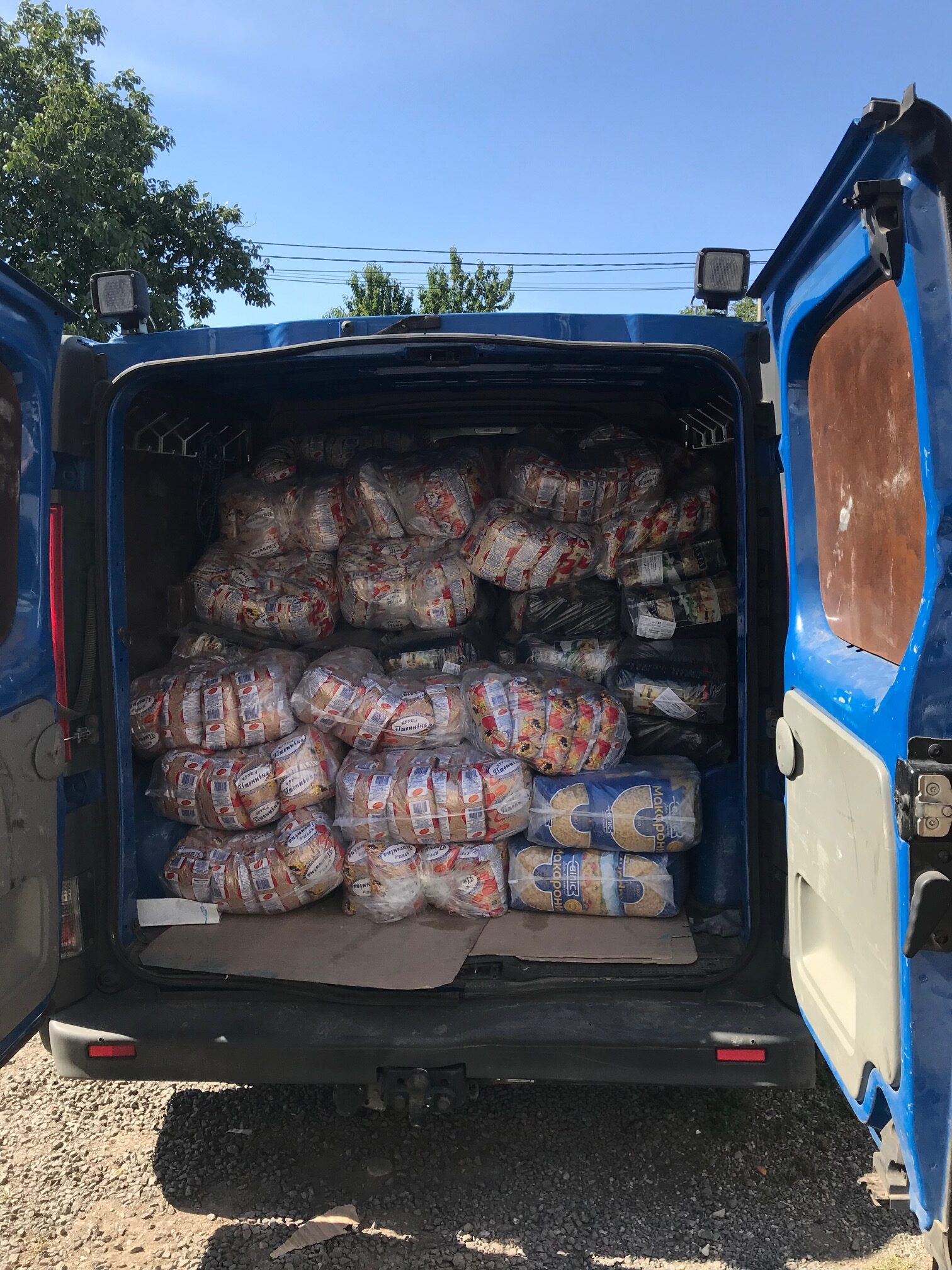 In the morning, we load pallets of canned tomato sauce, bags of pasta, rice, salt and other staples into the back of our vans. We frequently check the wheel wells to see how much the van is weighed down. The damage to the roads will be even worse in the direction we’re headed, and bottoming out the overloaded vehicle is a risk. Finally, with the tire dangerously close to rubbing against the top of he well, we decide that the van is full. “We may rub a little, but it should be fine,” Shannon declares.
In the morning, we load pallets of canned tomato sauce, bags of pasta, rice, salt and other staples into the back of our vans. We frequently check the wheel wells to see how much the van is weighed down. The damage to the roads will be even worse in the direction we’re headed, and bottoming out the overloaded vehicle is a risk. Finally, with the tire dangerously close to rubbing against the top of he well, we decide that the van is full. “We may rub a little, but it should be fine,” Shannon declares.
Obviously, coordinating a relief effort close to the front lines is a big job for the church, and there are a large number of people coming in and out all day long—They are church workers, but it seems doubtful that they were organizing bake sales and scheduling choir practice prior to February’s invasion.
These are people with certain skills, and a past, who can get things done.
One of them is the church pastor, Andriy* (*not his real name). He is a large, bearded man who arrives with a swagger at mid-morning, just before we start filling the vans. His presence fills the courtyard. Dressed all in camo with a “chaplain” lanyard bouncing off his barrel chest, he looks more like an action hero than a priest. His reputation has preceded him. When our NightHawk van went down the day before, we got a message to Andriy that we’d need a tow. The nine cans of gas that we brought with us are now empty—Andriy will get them filled. We hear that the Russians are planning to take out the bridges to the city—and undoubtedly, Andriy is the source of that intel.
Anna* is a sweet blonde woman who looks like the type of older mom or younger grandma who would manage a church’s business office, except that she wears a “Ukrainian Warrior” t-shirt and disappears for a few hours before coming back with the name of a city where we’ll be going today.
Boris* is a mysterious figure who appears at the church at random times. He wears patterned golf shirts and walks as if he has a bad hip, giving off a Michael Madsen vibe. He is constantly on the phone, interrupting his conversation on the cell to participate in our discussions.
On the day we were planning to work on roofs, doors and windows of bombing victims, he took his phone away from his ear and sternly told us not to go to the lumber store. They were too expensive.
“I know a place,” he said, and after driving, waiting, and driving some more, our van was filled with lumber and roofing material.
“He used to be a bad, bad guy,” Shannon whispers to us when he steps out to talk to someone. “Then he found Jesus. But a lot of people are in heaven today because he took an interest in them.”
That’s all the information on his background that we get, or need.
Anna tells us the name of the town we’re headed to. She also was the one that told us what supplies they needed, so we could load the van accordingly.
“Sometimes we deliver to the north,” Shannon said the night before. The “relatively safe” area is to the west. “Any direction but east means a pretty easy day.”
Our town today is about 20 minutes due east.
That means it’s time to put on the body armor. We each brought a Kevlar vest, which we fitted back in Cluj. We’re supposed to carry a tourniquet kit at all times, which I’ve been trained to use, along with the emergency anti-clotting pads and the chest pad (“just open it up and stick it on a chest wound to … y’know … keep everything inside.”)
The vans are loaded and Andriy and his “church assistant”, who looks anything but, are here. They will be making the trip east with us. And yet, we wait. The morning passes. At about 11:00, Shannon remarks, “We’re usually back by now. I’m not sure what’s going on.”
Close to noon, Andriy explains the delay to us. Kind of.
“We are waiting for military,” he says. “When they arrive…” He makes a sweeping hand motion that demonstrates arriving. “… we go.”
Church workers serve us lunch—soup and a large red cake, which is made from beets, potatoes, mayonnaise and what appears to be some type of fish. We guess anchovy or sardine.
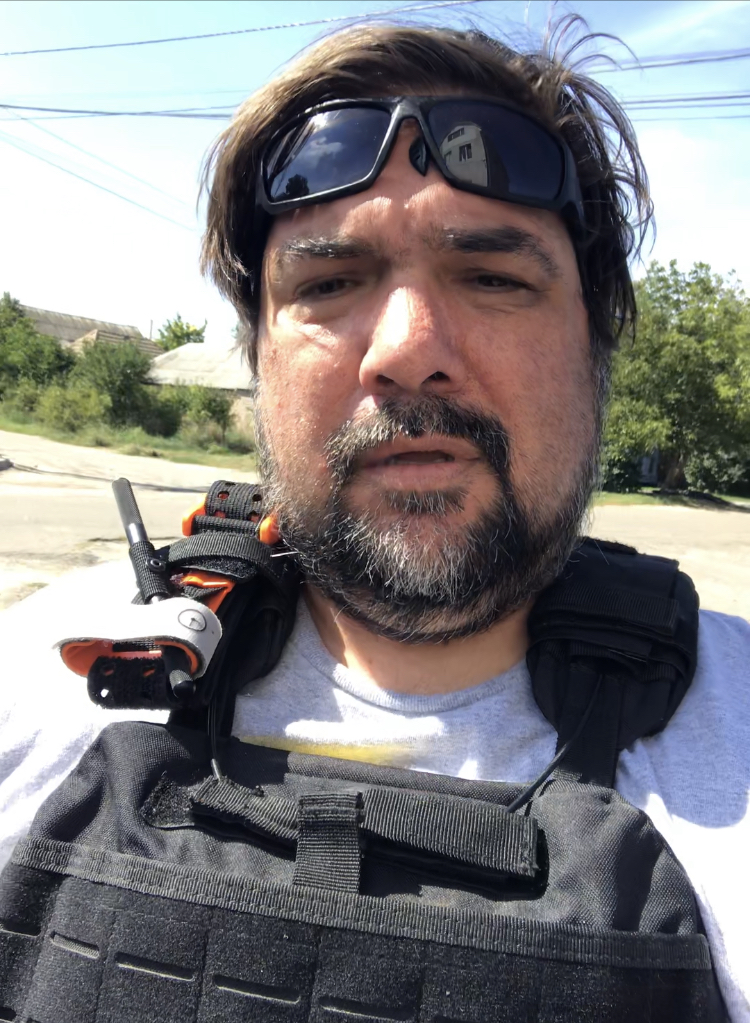 As soon as we finish eating, Andriy tells us to put on our vests. It’s almost time to go. We vest up and begin taking pictures of each other in armor.
As soon as we finish eating, Andriy tells us to put on our vests. It’s almost time to go. We vest up and begin taking pictures of each other in armor.
A large BOOM interrupts our revelry. This explosion can be measured in blocks away, not miles. It’s followed by a second and third BOOM, equally loud, the sound reverberating. After two more explosions, Andriy waves us into the vans. It’s time to go.
Apparently, the military has … hand sweep … arrived.
Each stop on our journey has seen layers of civilization peel away, as “normal life” becomes harder and harder to pursue for the people living there. The “relatively safe” area had restaurants and nightlife, but also the occasional minefield, and military checkpoints were routine.
The city in the war zone has people out running errands, but many of the errands are related to repairing damage, and raid sirens and full darkness curfews are part of each day.
As we head east, more and more remnants of civilization flake away. Every intersection on the main road is barricaded and most are staffed with soldiers toting rifles. We have our passports out and ready to give them, as we have at every checkpoint since entering Ukraine, but most don’t engage with us at the window. They just look at us as we approach and wave us on. Whatever they’re using to evaluate us doesn’t require showing ID.
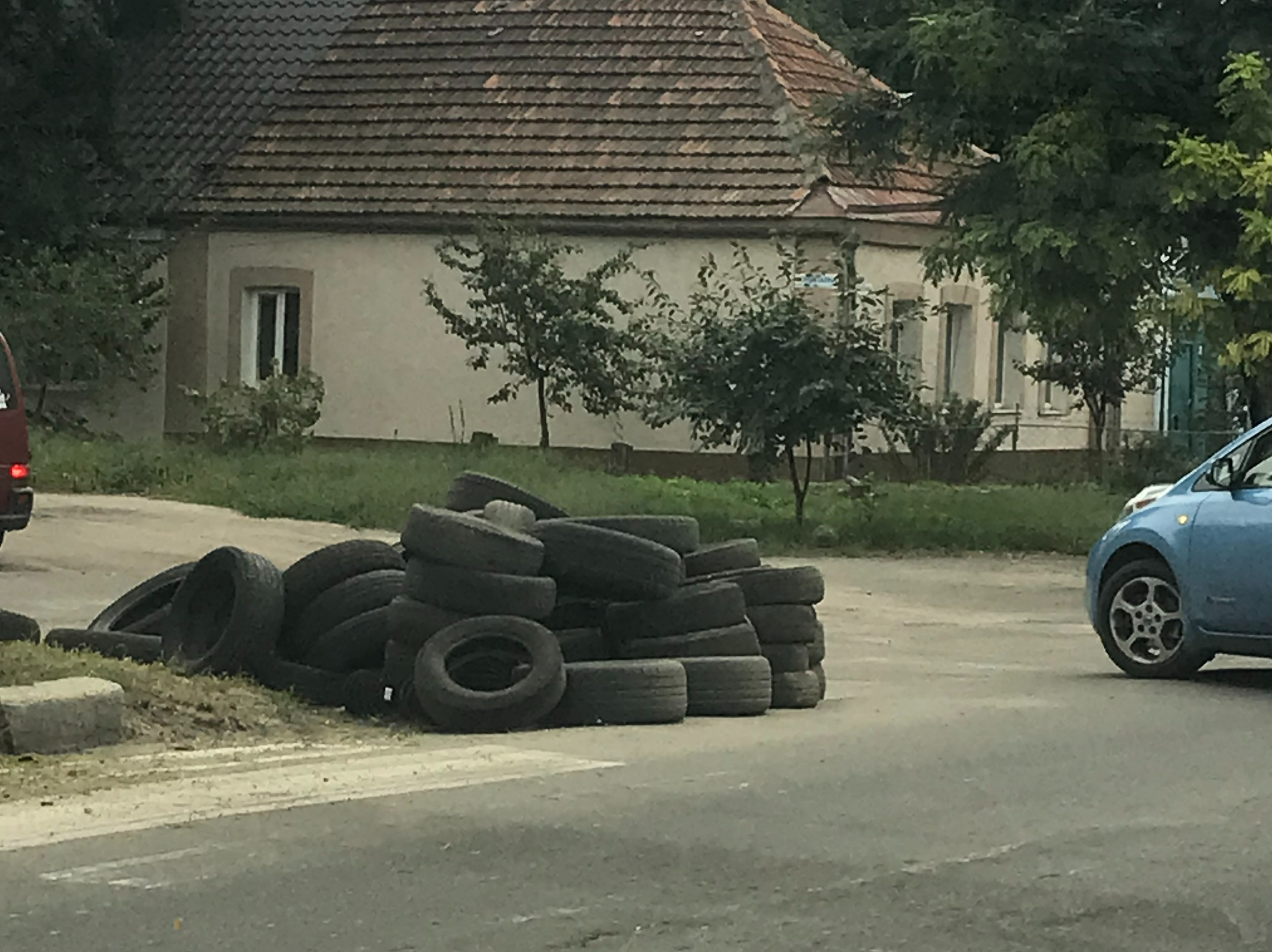 Each street corner has a pile of tires. We’re told that tires are an important part of defending a city. They can be used to construct barricades quickly or lit ablaze to create clouds of thick smoke.
Each street corner has a pile of tires. We’re told that tires are an important part of defending a city. They can be used to construct barricades quickly or lit ablaze to create clouds of thick smoke.
As we reach the eastern edge of the city, the barricades have soldiers standing, with a rocket launcher trained on the road in the direction we’re heading. Some of them have scarecrow dummies in camo and helmet, holding the launcher, but others are staffed by humans. Approaching the barricade from that direction, I’d imagine it would be very tough to tell which one is pointing it at you.
The road is pitted and potholes, and we swerve back and forth, spending almost as much time on the dirt shoulder on either side of the road as we do on the paved portion. We pass very few cars in either direction, although we do pull way to the left to allow a tank to pass by. The soldier in the turret gives us a wave and heads off toward the city.
The town we’re delivering to has been bombed every day for the last two weeks. We’re told that there isn’t a building in it that hasn’t sustained some type of damage.
We arrive at the town hall, or where it used to be. It’s a mass of rubble now.
The town mayor greets us as we get out of the van. She points to the bombed out town hall.
“My office,” she says and laughs.
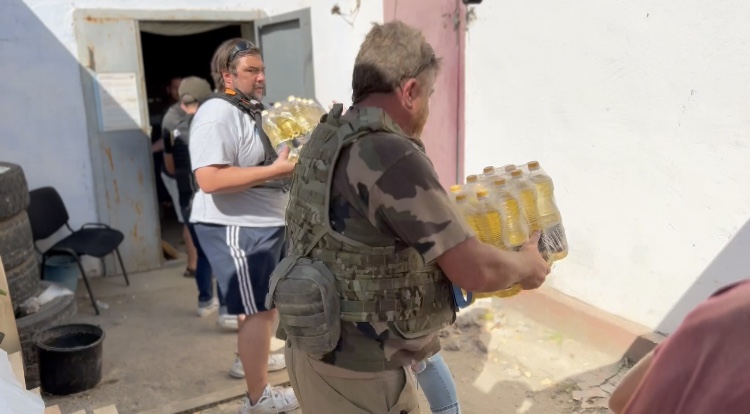 There are a number of other buildings on the town hall complex, and we back the van up to one. A team of about a half dozen people emerge and join us in setting up a bucket-brigade line to unload the van. Quickly, both vans are empty. The mayor asks us to join her in a selfie, and then we are back in and driving west again. The entire stop was less than 10 minutes.
There are a number of other buildings on the town hall complex, and we back the van up to one. A team of about a half dozen people emerge and join us in setting up a bucket-brigade line to unload the van. Quickly, both vans are empty. The mayor asks us to join her in a selfie, and then we are back in and driving west again. The entire stop was less than 10 minutes.
We approach the city, and I try to remember which checkpoints had humans on the launcher, and also, how long each shift on the barricade might last. We reenter the city and breathe a sigh of relief. We’ve made our first trip into the heart of the war without incident.
Andriy is gone, off to collect information and help plan our next delivery.
Oh, and in the time we were gone, despite being with us on the trip, Andriy has managed to get our gas cans filled.



